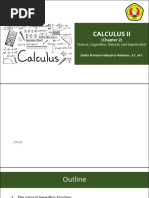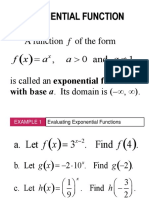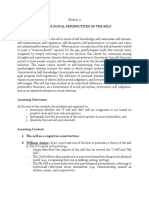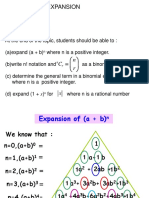Diff. Calc. Module 8 Exponential & Logarithmic Functions
Uploaded by
Wild RiftDiff. Calc. Module 8 Exponential & Logarithmic Functions
Uploaded by
Wild RiftRepublic of the Philippines
ISABELA STATE UNIVERSITY
Echague, Isabela
COLLEGE OF ENGINEERING
CE 111 – CALCULUS 1
1. Chapter 8: EXPONENTIAL AND LOGARITHMIC FUNCTIONS
2. Overview/Introduction
- Exponential and Logarithmic Functions
- Derivatives of Logarithmic Functions
- Derivatives of Exponential Functions
3. Learning Outcome/Objective
At the end of the discussion, the student should be able to:
1. Find the derivative of Logarithmic Functions;
2. Find the derivative of Exponential Functions; and;
3. Understand and Apply the Concepts of Differentiating Exponential Functions in
Solving Problems on Growth and Decay
4. Learning Content/Topic
I. EXPONENTIAL AND LOGARITHMIC FUNCTIONS
A function y is defined by the relation,
(𝟏) 𝑦=𝑎
where 𝑎 is a positive number other than one, is called an exponential function of 𝑥. The
graph, as shown in Figure 130 for 𝑎 > 1, indicates that the function (1) is positive, single-
valued, continuous and asymptotic to the 𝑥 axis. The function also has these properties
when 0 < 𝑎 < 1.
By the definition of a logarithm, the relation (1) is
equivalent to
(𝟐) 𝑥 = log 𝑦
Thus 𝑎 and log 𝑥 are inverse functions, and it follows
that
𝑎 =𝑥 𝑎𝑛𝑑 log 𝑎 = 𝑥
Figure 130
1 |Calculus 1 – Module 8: Exponential & Logarithmic Functions
Illustration 1. If 𝑦 = 2 , we may solve for 𝑥 by applying a series of inverse
operations; thus
sin 3𝑥 = log 𝑦
3𝑥 = sin (log 𝑦)
1
𝑥 = sin (log 𝑦)
3
A function y defined by the relation
(𝟑) 𝑦 = log 𝑥
Where 𝑎 is a positive number other than one, is called a logarithmic function of 𝑥. The
graph of (3), as shown in Figure 131, is the reflection of (2) with respect to the line 𝑦 = 𝑥.
We see from this graph that the logarithmic function is single-valued, continuous, asymptotic
to the 𝑦 axis, and defined only in the interval 0 < 𝑥 < ∞.
Operation involving logarithms are governed by the
properties listed below:
(a) log(𝑀𝑁) = log 𝑀 + log 𝑁
(b) log(𝑀/𝑁) = log 𝑀 − log 𝑁
(c) log 𝑀 = 𝑛 log 𝑀
(d) log √𝑀 = (1/𝑛) log 𝑀
(e) log 𝑏 = 1
(f) log 1 = 0
Illustration 2. If log 𝑥 = 1 − 3 log 2 +
log 5, by use of the laws of logarithms, we
obtain Figure 131
log 𝑥 = log 10 − log 2 + log √5
and
10√5
log 𝑥 = log
8
hence
5
𝑥 = √5
4
In the next topic, we will find that the differentiation formula for a logarithmic function involves
an irrational number which is denoted by 𝑒 and is defined by the limit
/
𝑒 = lim (1 + 𝑧)
→
A mathematical proof determining the existence of this limit is rather involved, and hence
will be omitted. Nevertheless, the accompanying table of values indicates that the limit does
exist and that approximately 𝑒 = 2.718 …
2 | Calculus 1 – Module 8: Exponential & Logarithmic Functions
z (1 + 𝑧) /
0.1 2.5937
0.01 2.7048
0.001 2.7169
0 ?
-0.001 2.7196
-0.01 2.7320
-0.1 2.8680
In mathematics, two systems of logarithms are particularly important. For computational
work, logarithms having the base 10 are the most convenient to use. These are called
common, or Briggsian loigarithms. For theoretical work, logarithms having the base e are
usually used. These are called natural or Napierian, logarithms. We shall denote the
common logarithm of N by 𝐥𝐨𝐠 𝑵 and the natural logarithm by 𝐥𝐧 𝑵. Thus 𝑦 = log 𝑥 means
𝑥 = 10 , whereas 𝑦 = ln 𝑥 means 𝑥 = 𝑒 . The relationship between log 𝑁 and ln 𝑁 can be
determined by taking the common and natural logarithms of the expression 𝑁 = 𝑒 ; thus
log 𝑁 = 𝑥 log 𝑒 𝑎𝑛𝑑 ln 𝑁 = 𝑥 ln 𝑒 = 𝑥
Hence, on eliminating x,
log 𝑁 = ln 𝑁 ∙ log 𝑒
and since log 𝑒 = log 2.718 = 0.4343, we obtain
log 𝑁 = 0.4343 ln 𝑁 𝑎𝑛𝑑 ln 𝑁 = 2.303 log 𝑁
The coefficient 𝑀 = 0.4343 is called the modulus of common logarithms.
Example I. If 𝑦 = 𝑒 − 𝑒 , find 𝑥 in terms of 𝑦.
Solution: Multiplying by 𝑒 , we have
𝑒 − 1 = 𝑦𝑒 , 𝑜𝑟 (𝑒 ) − 𝑦(𝑒 ) − 1 = 0
Solving by use of the quadratic formula, we obtain
1
𝑒 = 𝑦+ 𝑦 +4
2
where the root 𝑒 = 𝑦 + 𝑦 + 4 is rejected since 𝑒 is never negative.
Then, by taking logarithms, we find
1
𝑥 = ln 𝑦+ 𝑦 +4
2
Example 2. Show that log √𝑥 + 1 − √𝑥 = − log √𝑥 + 1 + √𝑥
Solution:
3 | Calculus 1 – Module 8: Exponential & Logarithmic Functions
Multiplying the numerator and denominator by √𝑥 + 1 + √𝑥 and making use of
the value log 1 = 0, we have,
(𝑥 + 1) − 𝑥
log √𝑥 + 1 − √𝑥 = log = − 𝐥𝐨𝐠 √𝒙 + 𝟏 + √𝒙
√𝑥 + 1 + √𝑥
Example 3. Sketch a graph of 𝑦 = 𝑥 𝑒
Solution:
We first observe that 𝑦 = 0 when 𝑥 = 0, and that
y is positive for all other values of x. Next we
observe that 𝑦 → 0 as 𝑥 → ∞ and 𝑦 → ∞ as 𝑥 →
−∞.
Drawing the curve in accordance with these
characteristics and estimating that 𝑦 = 2.7 when
𝑥 = −1, and 𝑦 = when 𝑥 = 2, we obtain the
Figure 132
graph shown in Figure 132.
II. DERIVATIVES OF LOGARITHMIC FUNCTIONS
When we apply the four-step rule in finding the derivative to the function 𝑦 = log 𝑥, we get
𝒅 𝐥𝐨𝐠 𝒂 𝒆 𝒅𝒖
(𝟐𝟐) 𝐥𝐨𝐠 𝒂 𝒖 = ∙
𝒅𝒙 𝒖 𝒅𝒙
For natural logarithms, the above formula becomes,
𝒅 𝟏 𝒅𝒖
(𝟐𝟑) 𝐥𝐧 𝒖 = ∙
𝒅𝒙 𝒖 𝒅𝒙
Illustration. If 𝑦 = log(2𝑥 + 1), then
𝑑𝑦 log 𝑒 0.8686
= (2) =
𝑑𝑥 2𝑥 + 1 2𝑥 + 1
Illustration. If 𝑦 = ln sin 𝑥, then
𝑑𝑦 1 𝑑 cos 𝑥
= ∙ sin 𝑥 = = cot 𝑥
𝑑𝑥 sin 𝑥 𝑑𝑥 sin 𝑥
Example. If 𝑦 = ln 𝑥 , find .
Solution: Making use of the properties of logarithms, we may write the given expression
in the form
1 1
𝑦 = 3 ln 𝑥 + ln(𝑥 − 1) − ln(𝑥 + 1)
2 2
4 | Calculus 1 – Module 8: Exponential & Logarithmic Functions
Hence,
𝑑𝑦 3 1 1 3𝑥 + 𝑥 − 3
= + − =
𝑑𝑥 𝑥 2(𝑥 − 1) 2(𝑥 + 1) 𝑥(𝑥 − 1)
III. DERIVATIVES OF EXPONENTIAL FUNCTIONS
𝒅 𝒖 𝒅𝒖
(𝟐𝟒) 𝒂 = 𝒂𝒖 𝐥𝐧 𝒂 ∙
𝒅𝒙 𝒅𝒙
For the base e, the above formula becomes
𝒅 𝒖 𝒅𝒖
(𝟐𝟓) 𝒆 = 𝒆𝒖 ∙
𝒅𝒙 𝒅𝒙
Illustration. If 𝑦 = 2 then
𝑑𝑦
= (2 )(ln 2)(3) = 2 ln 8
𝑑𝑥
Illustration. If 𝑦 = 𝑒 then
𝑑𝑦
= (𝑒 )(sec 5𝑥)(5) = 5𝑒 sec 5𝑥
𝑑𝑥
To find the derivative of an exponential function of the form 𝑢 where 𝑢 and 𝑣 are both
functions of 𝑥, we differentiate the logarithm of the function.
Illustration. If 𝑦 = 𝑥 , then ln 𝑦 = 𝑥 ln 𝑥. Differentiating, we obtain
1 𝑑𝑦 1
= (1)(ln 𝑥) + 𝑥
𝑦 𝑑𝑥 𝑥
𝑑𝑦
= 𝑥 (1 + ln 𝑥)
𝑑𝑥
To work involved in differentiating an algebraic function is often simpler if logarithms are
used.
( ) / ( ) /
Example. Find dy/dx if 𝑦 =
( )
Solution: taking natural logarithms, we have
3 1
ln 𝑦 = ln(𝑥 − 1) + ln(𝑥 − 3) − 2 ln(𝑥 − 2)
2 2
Differentiating, we obtain
1 𝑑𝑦 3 1 2
= + −
𝑦 𝑑𝑥 2(𝑥 − 1) 2(𝑥 − 3) 𝑥 − 2
1 𝑑𝑦 3(𝑥 − 5𝑥 + 6) + (𝑥 3𝑥 + 2) − 4(𝑥 − 4𝑥 + 3)
=
𝑦 𝑑𝑥 2(𝑥 − 1)(𝑥 − 2)(𝑥 − 3)
5 | Calculus 1 – Module 8: Exponential & Logarithmic Functions
1 𝑑𝑦 𝑥−4
=−
𝑦 𝑑𝑥 (𝑥 − 1)(𝑥 − 2)(𝑥 − 3)
Multiplying both sides by y and simplifying, we find
𝑑𝑦 (𝑥 − 1) (𝑥 − 4)
=−
𝑑𝑥
(𝑥 − 3) (𝑥 − 2)
A situation frequently encountered in certain problems of biology, chemistry, and economics
is one in which the rate of change of a substance with respect to time is proportional to the
amount of the substance present at a given time. Such is the case, for example in
considering the decomposition of a radioactive substance or the growth of bacteria culture
under ideal circumstances.
If the positive function 𝑓(𝑡) represents the amount of substance present at time 𝑡, the
preceding law can be stated mathematically as
(1) 𝑓 (𝑡) = 𝑘 𝑓(𝑡)
Where k is a constant and 𝑡 ≥ 0. The function 𝑓(𝑡) can be determined explicitly by writing
(1) in the form
𝑓 (𝑡)
= 𝑘, 𝑤ℎ𝑒𝑛𝑐𝑒 ln 𝑓(𝑡) = 𝑘𝑡 + 𝑐
𝑓(𝑡)
By finding the antilogarithm if this latter expression, we obtain
(𝟐) 𝑓(𝑡) = 𝐴𝑒
Where 𝐴 = 𝑒 is a positive constant.
If the constant 𝑘 is positive, the function 𝑓(𝑡) increases in what is called an exponential law
of growth. If 𝑘 is negative, 𝑓(𝑡) decreases in what is called an exponential law of decay.
Example. If the half life of radium is 1600 years and we start with 100 milligrams, find
the amount of radium remaining after t years.
Solution:
To say that the half life of radium is 1600 years means that half of the original amount
or 50 milligrams will remain after 1600 years.
Thus, by substitution in (2), we find
100 = 𝐴𝑒 𝑎𝑛𝑑 50 = 𝐴𝑒
Hence 𝐴 = 100, and from 𝑒 = we have
1
1600 𝑘 = ln ;
2
Therefore,
6 | Calculus 1 – Module 8: Exponential & Logarithmic Functions
− ln 2
𝑘= = −0.00043
1600
This gives
.
𝑓(𝑡) = 100𝑒
as the law of decay for the given quantity of radium.
5. Teaching and Learning Activities
EXERCISES
Solve for x in each of the following:
1. log 𝑥 = − 8. (0.015) = (0.34)
9. ln 𝑥 = 1 + 2 ln 2
2. ln 𝑥 = 3
3. log 𝑥 = 2 − log 2 10. ln ln 𝑥 = 1
4. log 𝑥 = 0 11. 4 ln tan 𝑥=1
12. ln sin 𝑥 = 1 + ln cos 𝑥
5. 2 = 4
13. 𝑒 − 5𝑒 =4
6. 𝑒 = 3
14. 2 + 4 = 8
7. 3 =5
15. 4 + 4 =4
In each of the following, solve for 𝒙 in terms of 𝒚.
16. 𝑦 = 𝑒 21. 𝑦 = ln sin 𝑥
17. 𝑦 = 10 22. 𝑦 = tan (log 2𝑥)
18. 𝑦 = 𝑒 23. 𝑦 = (𝑒 + 𝑒 )
19. 𝑦 = log 3𝑥 24. 𝑦 = tan 𝑒 + cot 𝑒
20. 𝑦 = ln 9𝑥 25. 𝑦 = 𝑒 − 3𝑒 + 3𝑒
Differentiate each of the following functions
26. ln(𝑥 − 1) 35. ln ln 𝑥
27. log (𝑥 + 3𝑥) 36. 𝑒
28. ln √2𝑥 − 5 37. 3
29. ln 𝑥 √𝑥 + 1 38. 𝑒
30. log 39. 𝑥 𝑒
31. ln 𝑥 + √𝑥 + 1 40.
32. ln 41. (1 − 𝑎 )
42. 𝑒 (𝑥 − 2𝑥 + 2)
( )
33. ln
( ) 43. 𝑒 cos 5𝑥
34. log(𝑥 sin 𝑥) 44. 𝑒
7 | Calculus 1 – Module 8: Exponential & Logarithmic Functions
45. 𝑒 50. 𝑥 𝑒
51. 𝑥 𝑒
46.
52. 𝑥
53. (cos 𝑥)
47. ln
54. (sin 𝑥)
48. ln sin 𝑒
55. √𝑥 + 1/ √𝑥 + 2
49. tan 2
56. In the chemical processing of a certain mineral, the rate of change of the amount of
mineral present varies as the amount of the mineral remaining. If, after 8 hours, 100
pounds of mineral have been reduced to 70 pounds, what quantity of the mineral will
remain after 24 hours?
57. If in a certain city the rate of increase on population is proportional to the population at
any time, and if in the last ten years the population is increased from 100,000 to
120,000, what will be the population of the city ten years from now?
6. Flexible Teaching Learning Modality (FTLM) adapted
Example:
Edmodo, google classroom, module, case study, exercises, problem sets, etc.
7. Assessment Task
Assessment Task will be a 30-point quiz covering the topics discussed in this module.
In addition, a long exam will be given at the end of the term
8. References (Copyrighted within the last 10 years)
This contains the list of references/readings which students can explore.
Love, C.E. Ph.D, Rainville E.D. Ph.D. Differential and Integral Calculus.
MACMILLAN PUBLISHING CO., INC.
Peterson, T.S. Calculus with Analytic Geometry. Ken Incorporated, Quezon City
8 | Calculus 1 – Module 8: Exponential & Logarithmic Functions
You might also like
- Lesson 5: 5.1 Exponentials and LogarithmsNo ratings yetLesson 5: 5.1 Exponentials and Logarithms24 pages
- Unit 4 Packet Exponents and Logs Fall 15No ratings yetUnit 4 Packet Exponents and Logs Fall 1526 pages
- Exponential and Logarithmic Functions: Laws of ExponentialsNo ratings yetExponential and Logarithmic Functions: Laws of Exponentials17 pages
- L11 Exponential and Logarthmic FunctionsNo ratings yetL11 Exponential and Logarthmic Functions25 pages
- Lecture 12. Derivatives of Log - FunctionsNo ratings yetLecture 12. Derivatives of Log - Functions5 pages
- Chapter 8 Exponential and Logarithmic Functions1No ratings yetChapter 8 Exponential and Logarithmic Functions113 pages
- Lesson 11 - Exponential and Logarithmic FunctionsNo ratings yetLesson 11 - Exponential and Logarithmic Functions25 pages
- L6-Exponential and Logarithmic FunctionsNo ratings yetL6-Exponential and Logarithmic Functions33 pages
- Lesson 16 Derivatives of Logarithmic and Exponential Functions DIFF CALNo ratings yetLesson 16 Derivatives of Logarithmic and Exponential Functions DIFF CAL8 pages
- Week 6 Advance Differentiation Rules Exponential and Logarithmic FunctionsNo ratings yetWeek 6 Advance Differentiation Rules Exponential and Logarithmic Functions21 pages
- Exponential and Logarithmic Functions 3No ratings yetExponential and Logarithmic Functions 325 pages
- Lesson 1.3 Exponential and Logarithmic FunctionsNo ratings yetLesson 1.3 Exponential and Logarithmic Functions12 pages
- Lecture 3 Exponential and Logarithmic FunctionsNo ratings yetLecture 3 Exponential and Logarithmic Functions58 pages
- Lesson 5 Differentiation of Transcendental FunctionsNo ratings yetLesson 5 Differentiation of Transcendental Functions44 pages
- Week 7 Derivative of Exponential and Logarithmic FunctionsNo ratings yetWeek 7 Derivative of Exponential and Logarithmic Functions6 pages
- Introduction To Exponential & Logarithmic FunctionsNo ratings yetIntroduction To Exponential & Logarithmic Functions3 pages
- Inverse Functions and Their DerivativesNo ratings yetInverse Functions and Their Derivatives13 pages
- Ch+07+Integrals+and+Transcendental+Functions 1130546No ratings yetCh+07+Integrals+and+Transcendental+Functions 113054616 pages
- MAT111 Week 7 Lesson 2 Trigonometric Functions Sep 2021No ratings yetMAT111 Week 7 Lesson 2 Trigonometric Functions Sep 20214 pages
- Derivatives of Logarithmic and Exponential FunctionsNo ratings yetDerivatives of Logarithmic and Exponential Functions9 pages
- Exponential & Logarithmic Functions Logarithmic Functions Logarithms Were Invented by John Napier Because of His Interest in Reducing ComplexNo ratings yetExponential & Logarithmic Functions Logarithmic Functions Logarithms Were Invented by John Napier Because of His Interest in Reducing Complex8 pages
- Exponential Function: A Function F of The FormNo ratings yetExponential Function: A Function F of The Form115 pages
- Engineering Management: Engr. Edmundo A. ObinaNo ratings yetEngineering Management: Engr. Edmundo A. Obina54 pages
- Chapter 1 - Republic Act 1425 - 202203071048No ratings yetChapter 1 - Republic Act 1425 - 2022030710488 pages
- Tangonan, Christian Paul Amigo BSABE 1-1 Abe 112 Physics For EngineersNo ratings yetTangonan, Christian Paul Amigo BSABE 1-1 Abe 112 Physics For Engineers2 pages
- Isabela State University College of Engineering Course Syllabus Course Number Course Title Credit Unit/s Hours Per Week CE 212No ratings yetIsabela State University College of Engineering Course Syllabus Course Number Course Title Credit Unit/s Hours Per Week CE 2125 pages
- Subject Code and Description: CE 212 - Computer Aided Drafting Semester/A.Y.: First Semester A.Y. 2021-2022No ratings yetSubject Code and Description: CE 212 - Computer Aided Drafting Semester/A.Y.: First Semester A.Y. 2021-20222 pages
- Tangonan, Christian Paul Amigo BSABE 1-1 Abe 112 Physics For EngineersNo ratings yetTangonan, Christian Paul Amigo BSABE 1-1 Abe 112 Physics For Engineers2 pages
- Employment Application Letter: Reading and Writing Skills100% (2)Employment Application Letter: Reading and Writing Skills24 pages
- Module 4 - Psychological Perspectives of The SelfNo ratings yetModule 4 - Psychological Perspectives of The Self7 pages
- Prelim Coverage - Chapter 1: The Study of GlobalizationNo ratings yetPrelim Coverage - Chapter 1: The Study of Globalization20 pages
- Instant download (Ebook) Complex analysis by David Orme Tall; Ian Stewart ISBN 9781108436793, 110843679X pdf all chapter100% (1)Instant download (Ebook) Complex analysis by David Orme Tall; Ian Stewart ISBN 9781108436793, 110843679X pdf all chapter55 pages
- Aakash - Binomial Theorem and Its ApplicationNo ratings yetAakash - Binomial Theorem and Its Application8 pages
- Get Complex Variables 1st Edition Joseph L. Taylor free all chapters100% (7)Get Complex Variables 1st Edition Joseph L. Taylor free all chapters59 pages
- Section 2.4 Precise Definition of The LimitNo ratings yetSection 2.4 Precise Definition of The Limit8 pages
- H2 MYE Revision Package Techniques of Differentiation SolutionsNo ratings yetH2 MYE Revision Package Techniques of Differentiation Solutions5 pages
- CH 8-5 Adding and Subtracting PolynomialsNo ratings yetCH 8-5 Adding and Subtracting Polynomials13 pages
- Operator Theory Systems Theory and Scattering Theory Multidimensional GeneralizationsNo ratings yetOperator Theory Systems Theory and Scattering Theory Multidimensional Generalizations326 pages
- K03052 - 20200424155139 - 7.1 Integration - Integration by Parts MethodNo ratings yetK03052 - 20200424155139 - 7.1 Integration - Integration by Parts Method19 pages
- Resurgence in Geometry and Physics: Brent Pym Trinity Term 2016No ratings yetResurgence in Geometry and Physics: Brent Pym Trinity Term 201611 pages
- Topic 1 Am015 Number System and Equation 2024-2025No ratings yetTopic 1 Am015 Number System and Equation 2024-202517 pages
- Cambridge Methods 3&4 - Chapter 6 - Circular Functions - SolutionsNo ratings yetCambridge Methods 3&4 - Chapter 6 - Circular Functions - Solutions59 pages
- Exponential and Logarithmic Functions: Laws of ExponentialsExponential and Logarithmic Functions: Laws of Exponentials
- Lesson 16 Derivatives of Logarithmic and Exponential Functions DIFF CALLesson 16 Derivatives of Logarithmic and Exponential Functions DIFF CAL
- Week 6 Advance Differentiation Rules Exponential and Logarithmic FunctionsWeek 6 Advance Differentiation Rules Exponential and Logarithmic Functions
- Lesson 5 Differentiation of Transcendental FunctionsLesson 5 Differentiation of Transcendental Functions
- Week 7 Derivative of Exponential and Logarithmic FunctionsWeek 7 Derivative of Exponential and Logarithmic Functions
- Introduction To Exponential & Logarithmic FunctionsIntroduction To Exponential & Logarithmic Functions
- Ch+07+Integrals+and+Transcendental+Functions 1130546Ch+07+Integrals+and+Transcendental+Functions 1130546
- MAT111 Week 7 Lesson 2 Trigonometric Functions Sep 2021MAT111 Week 7 Lesson 2 Trigonometric Functions Sep 2021
- Derivatives of Logarithmic and Exponential FunctionsDerivatives of Logarithmic and Exponential Functions
- Exponential & Logarithmic Functions Logarithmic Functions Logarithms Were Invented by John Napier Because of His Interest in Reducing ComplexExponential & Logarithmic Functions Logarithmic Functions Logarithms Were Invented by John Napier Because of His Interest in Reducing Complex
- Tangonan, Christian Paul Amigo BSABE 1-1 Abe 112 Physics For EngineersTangonan, Christian Paul Amigo BSABE 1-1 Abe 112 Physics For Engineers
- Isabela State University College of Engineering Course Syllabus Course Number Course Title Credit Unit/s Hours Per Week CE 212Isabela State University College of Engineering Course Syllabus Course Number Course Title Credit Unit/s Hours Per Week CE 212
- Subject Code and Description: CE 212 - Computer Aided Drafting Semester/A.Y.: First Semester A.Y. 2021-2022Subject Code and Description: CE 212 - Computer Aided Drafting Semester/A.Y.: First Semester A.Y. 2021-2022
- Tangonan, Christian Paul Amigo BSABE 1-1 Abe 112 Physics For EngineersTangonan, Christian Paul Amigo BSABE 1-1 Abe 112 Physics For Engineers
- Employment Application Letter: Reading and Writing SkillsEmployment Application Letter: Reading and Writing Skills
- Prelim Coverage - Chapter 1: The Study of GlobalizationPrelim Coverage - Chapter 1: The Study of Globalization
- Instant download (Ebook) Complex analysis by David Orme Tall; Ian Stewart ISBN 9781108436793, 110843679X pdf all chapterInstant download (Ebook) Complex analysis by David Orme Tall; Ian Stewart ISBN 9781108436793, 110843679X pdf all chapter
- Get Complex Variables 1st Edition Joseph L. Taylor free all chaptersGet Complex Variables 1st Edition Joseph L. Taylor free all chapters
- H2 MYE Revision Package Techniques of Differentiation SolutionsH2 MYE Revision Package Techniques of Differentiation Solutions
- Operator Theory Systems Theory and Scattering Theory Multidimensional GeneralizationsOperator Theory Systems Theory and Scattering Theory Multidimensional Generalizations
- K03052 - 20200424155139 - 7.1 Integration - Integration by Parts MethodK03052 - 20200424155139 - 7.1 Integration - Integration by Parts Method
- Resurgence in Geometry and Physics: Brent Pym Trinity Term 2016Resurgence in Geometry and Physics: Brent Pym Trinity Term 2016
- Topic 1 Am015 Number System and Equation 2024-2025Topic 1 Am015 Number System and Equation 2024-2025
- Cambridge Methods 3&4 - Chapter 6 - Circular Functions - SolutionsCambridge Methods 3&4 - Chapter 6 - Circular Functions - Solutions














































































































